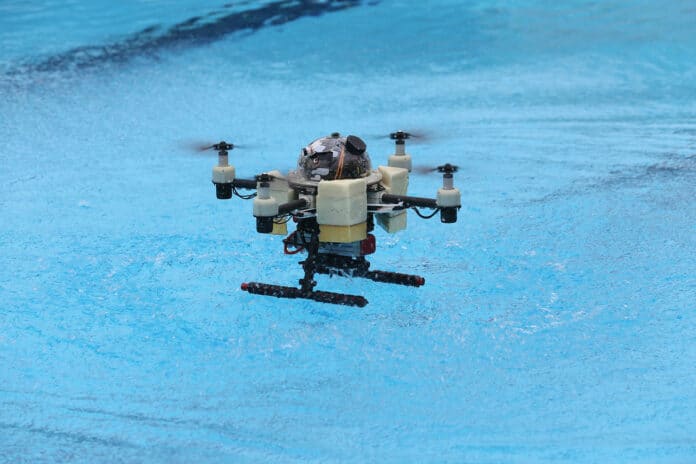Although aerial drones are known for their ability to cover long distances rapidly, aquatic drones can explore underwater environments. The TJ-FlyingFish offers the best of both worlds, as it is an unprecedented amphibious drone that can fly through the air and navigate through the deep sea.
Launched in early February 2023, the TJ-FlyingFish was developed by a research team from China’s Shanghai Research Institute for Intelligent Autonomous Systems, Tongji University, and the Unmanned Systems Research Group at the Chinese University of Hong Kong.
The TJ-FlyingFish has a light design and weighs just 1.63 kilograms. The design of this amphibious drone is reminiscent of any other quadcopter, with a central domed body and four arms, each one equipped with a motor or propeller module. However, its design features several other unique elements, with four arms that each have a propulsion unit at the end. These units incorporate a special dual-speed gearbox, plus the arm on which it’s mounted can rotate independently to allow optimal air or water movement.
“For propulsion, the operating range is switched for the different media by the dual-speed propulsion unit, providing sufficient thrust and also ensuring output efficiency. For thruster configuration, thrust vectoring is realized by the rotation of the propulsion unit around the mount arm, enhancing the underwater maneuverability,” said Professor Ben Chen, who led the development of the new drone.
When the aircraft is in flight, all four units face upwards and spin their props at high speed. Once the drone lands on water, the units rotate to face downward and then spin at a lower speed, pulling the drone beneath the surface. To move both horizontally and vertically while underwater, the drone adjusts the angle and thrust of each propulsion unit as needed.
According to the researcher, the aerial-aquatic hybrid drone operates autonomously, without the need for human intervention during its journey. It is equipped with a cross-domain positioning and navigation system consisting of GPS, an inertial measurement unit, a depth meter, and a mini Doppler velocity log, which enables autonomous control during its entire amphibious journey.
The TJ-FlyingFish can hover for six minutes in the air or dive underwater for about 40 minutes per battery charge. It is also capable of descending to a maximum depth of three meters and moving up to two meters per second in water.
This remarkable creation is a game-changing tool for a wide range of applications, such as conducting aerial and aquatic surveys, assisting with offshore construction, remote sensing, and search-and-rescue operations, among others.
“We are thrilled to unveil the TJ-FlyingFish, which represents a major milestone in our research efforts. We have simplified its structure and reduced its weight to ensure it can operate smoothly in water and sky media. We are excited to see how it will be used in the future,” explained Professor Ben Chen.
